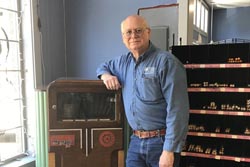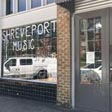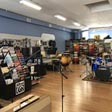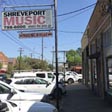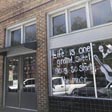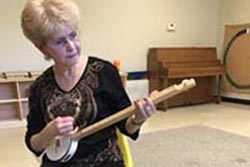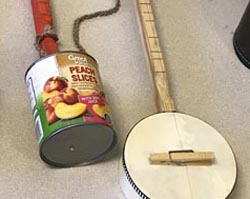Innovation, Tradition, and Change in Louisiana Musical Instrument Making and Repair
By Holly Hobbs

North Louisiana
Don Teach, Piano repair/music store owner
Don Teach is the former owner of Shreveport Music Company, located at 115 Kings Highway in Shreveport. While Shreveport Music, which opened in 1910, began as a piano store, they no longer sell pianos at all—only digital keyboards. Don Teach talks about the changes in the music store over the decades of his ownership, as well as his own thoughts about the future of the music store in Louisiana.
Don Teach was born and raised in Shreveport. His father was a pianist and worked at a music store in Shreveport before becoming an organ dealer and partnering with the then owner of Shreveport Music, finally taking over the ownership of the store in 1961. When his father died, Don took over the store. Don grew up fascinated by pianos—particularly old pianos and player pianos—and from as early as he can remember he was tinkering with things, attempting to figure out how they worked and how the parts fit together. He was a Leslie Speaker salesman for a time, along with Hammond organs, living and working in California. When Leslie Speakers went out of business, Don returned to Shreveport and the day-to-day management of the store. He knew nothing about running a music shop, he admits, and had to learn over time how to work with instrument dealers and customers.
When business started to decline, he found a stable revenue stream in renting instruments to the many local casinos in the area. When asked why Shreveport Music has stayed in business since 1910, Mr. Teach replies:
During my tenure here, my dad made a list, he said, you've had 17 competitors come and go since you've been here. It's nothing I did. . . . The store itself has just had some phenomenally good people working for it. I was just lucky. I had good people. I had the brand names.
Shreveport Music was probably the biggest that there was [in the area]. . . . Yamaha would come to me and tell me, you know, you're like number 12 in the nation for [sound equipment] sales. Amazon.com was number 11, I was number 12. . . . At one point I was doing so many Shure microphones I became a distributor for Shure microphones. I was at that level.
He continues, "I advertised all the time that I had the same prices as the Internet or lower. You bring me a price on the Internet, I'll match it or beat it. On any new item."
Don says he's not a musician, simply a repairer and a mechanic and technician. He laments the changes to the piano industry over time, and notes the exponential downturn in piano sales. The guitar industry, he says, has now, too, begun to fail. When asked whether these things are cyclical, he said he believes them not to be. "Digital creation is simply too easy these days," he asserts.
In discussing his piano repair, Don talks at length about the difficulty in finding parts to repair old and rare pianos. Because of this, he began building his own parts. The first piano he ever worked on was a player piano at age 12. He pulled it apart and learned from his dad's business partner to rebuild it. "At age 12, I spent the summer rebuilding that piano," he remembers. He continued this work through high school, and by that time had become something of an expert in player pianos. It was a passion from the beginning, he said. He learned from others with the help of a player piano manual. He went on to apprentice with a master piano technician in Monroe, Louisiana, along with a number of others throughout the country, learning more about his craft. Master workmanship was important to him, and he dedicated all his free time to perfecting and learning more about the work. Don elaborates:
All I've done my whole life is try to become a better piano craftsman. To the point that now, I put soundboards in pianos, I'll do bridge work. I do things in pianos that no one in the state has ever wanted to do. You can bring me a piano that's been under water. You could bring me one of those flood pianos out of Baton Rouge, I can put it back. I can make it brand new. I just finished doing one for a guy that was in Switzerland, he sent it to me. The back looked like you'd gone through it with a forklift and they tore the piano up, I built it all back.
When asked how his clients find him, he responds:
I have no website, it's word of mouth. And I have a big mouth [laughs]. The Swiss guy had dealt with a guy in California, and I had done work for him, and he found out about me because I make parts. When I got into this player piano thing, and was trying to find parts, and I need this little metal thing, and I'd call Dave Ramey. There was a collector's club, known restorers. He said he didn't have any left, [and that] I'll find one sooner or later. And I said, "I want one now." And so I'd take one to the local machine shops and they'd say yeah, it's easy enough to make but we don't want to mess with you. You're too small. . . . Finally I got one guy that says, . . . "That's simple, I'll make it." And he charged me $16 to make a little piece.
Because of this experience, he went to trade school for two years to learn how to be a machinist, just so he could learn how to make parts he needed for player pianos. He says the enjoyment in all of the work he does is in the small details.

Gladys Miller, Canjo/dulcimer making/repair
Canjo maker Gladys Miller lives in rural Sieper, Louisiana, but makes the drive to larger Alexandria, Louisiana, multiple times per week. She is in the process of starting to learn how to build dulcimers and is also a talented painter and visual artist. She discusses her upbringing, her faith, and the importance and connection of spirituality and music.
Gladys Miller grew up in a rural area along the Calcasieu River. Her father was a fiddler and a guitarist and she grew up hearing the old-time songs of her father's repertoire. Although she sang in choir, she never played an instrument in her youth. Her family was Assembly of God, and at age 12 she was called to preach to the young children in her rural area, since there was no Sunday School available to them. She drove her father's truck around the area and picked up local children, bringing them to her yard to preach. It wasn't until later on in her life when she switched to the Methodist faith that she finally fulfilled her life-long dream of being a preacher.
Mrs. Miller had always wanted to play an instrument, but it wasn't until she had an experience with the dulcimer that she felt that she was ready. She ordered her first dulcimer from Mountain View, Arkansas, and began teaching herself to play. Now she's a licensed McSpadden dulcimer dealer in the state of Louisiana, helping others to purchase their own dulcimers and giving informal lessons. During this time, she saw a picture of a canjo (a type of one-stringed lyre/banjo) in a magazine, and she was immediately drawn to it, thinking that she and her husband would be able to make one. She said they had trouble trying to get the fret board correct at first, but over time, with trial and error, she has perfected the process and now sells her canjos locally and at music festivals all over north Louisiana and beyond.
To make the resonating body of the instrument, she uses old cans (peach cans are among her favorites). As she is also a painter, she often paints designs on the fret boards. She sews the straps as well. She elaborates:
Believe it or not, it takes a good long while to make one of these. The fret wire, it comes in a roll. And you measure your wire and I cut it with some snippers and I have a special little saw. . . . The little teeth of it only saws so deep, and you get the frets in the right space. And then I have a rubber hammer and my husband built me a frame and it has pieces of wood on each side and I slide down the frame so it holds it tight. And then mark my lines, cut the little holes, take my little rubber hammer and hammer it down. . . . It takes quite a while to build one of these.
My husband cuts the wood for me. . . . You can use pine. . . . Sometimes I'll just leave it natural wood and put a little stain on it. Some people like that. This is a goat skin, and you have to have something that makes the vibrations go into the goat skin. And this clothespin with the piece of wood, actually if I take it out, you don't get any [sound]. So when you put [the clothespin] back under there, that vibration actually goes under the clothespin wood and you can move it around to kind of have different sounds.
Gladys says she does not know of any other canjo makers in Louisiana. When asked about being a female instrument maker, she says it's a benefit, rather than a detriment, because women in her opinion feel things better and are more attuned to fine details. She also has an old-time all-female band, called The Fret Knots, with whom she performs in the area. Since it had always been her dream to learn an instrument, and since she's found success with the dulcimer and the canjo, she says she'd like to start learning ukulele next, followed by learning to build dulcimers.
Music and spirituality are deeply connected for Gladys, and her favorite repertoire is old-time gospel. She has gone on several different church missions, one recently to Peru, and brought canjos with her to give to the children there. It is her life's work, she says, to serve God through music.



